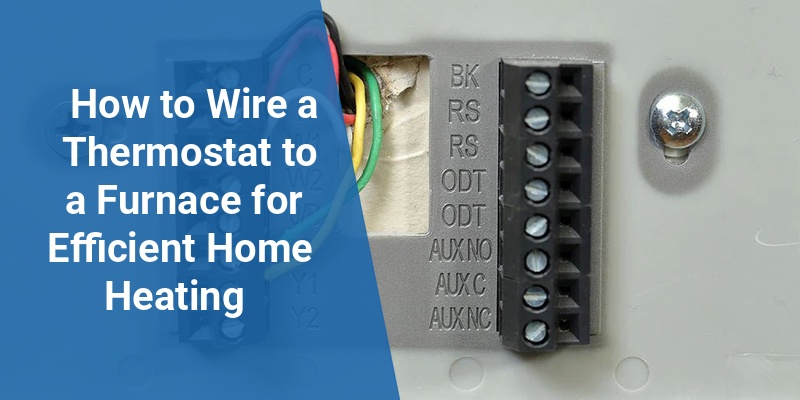Wiring a thermostat to a furnace is a critical step in setting up an efficient heating system in any home. This process ensures that the thermostat correctly communicates with the furnace to regulate temperature effectively. Whether upgrading an existing thermostat or installing a new furnace system, understanding the wiring connections is essential. This guide covers the key wiring steps, common wire colors, and troubleshooting tips to help homeowners and professionals alike achieve optimal furnace performance.
| Wire Color | Common Function | Description |
|---|---|---|
| Red (R or Rh) | Power | Provides 24V power from furnace or transformer |
| White (W) | Heat | Controls heating signal to furnace |
| Yellow (Y) | Cooling | Used for air conditioning compressor activation |
| Green (G) | Fan | Controls the furnace blower fan |
| Common (C) | Common Wire | Provides return path for continuous power |
Understanding Thermostat and Furnace Wiring Basics
The thermostat serves as the control center for the furnace, regulating temperature by signaling the furnace to turn heating on or off. Wiring a thermostat correctly ensures seamless communication between the two devices, preventing operational errors or system failures. Most modern thermostats operate on low-voltage control circuits, typically 24 volts supplied by the furnace’s transformer.
Common thermostat wires include: power (often red), heat (white), fan (green), cooling (yellow), and sometimes a common wire (blue or black) for continuous power. Identifying and connecting these wires properly is crucial to system performance and safety.
Step-by-Step Guide to Wiring a Thermostat to a Furnace
Turn Off Power to the HVAC System
Before starting any wiring work, shut off power at the furnace and the breaker panel to ensure safety and prevent electrical shocks or damage.
Identify and Label Existing Thermostat Wires
Remove the old thermostat, if applicable, and label each wire according to its terminal letter (R, W, Y, G, C). Use masking tape or wire labels for clear identification.
Understand Terminal Functions on the Furnace Control Board
Locate the furnace control board and identify the corresponding terminals (R, W, etc.). Consult the furnace’s manual for terminal location and designation, as these can vary by model.
Connect Wires from Thermostat to Furnace
- Red Wire (R): Connect to the R terminal to supply 24V power.
- White Wire (W): Connect to the W terminal which controls the heating relay.
- Green Wire (G): Connect to the G terminal to control the blower fan operation.
- Yellow Wire (Y): Usually connected to Y for cooling; if no cooling, leave disconnected.
- Common Wire (C): Connect if present, to C terminal to complete the circuit and provide continuous power, especially needed for smart thermostats.
Secure Connections and Mount the Thermostat
Ensure all wire connections are tight and free from corrosion or damage. Mount the thermostat on the wall, following manufacturer instructions.
Call 888-906-9139 for Free Local HVAC Quotes – No Obligation, Just Savings!
Restore Power and Test the System
Turn the power back on at the breaker and furnace. Set the thermostat to heat mode and adjust the temperature above the current room temperature. Verify the furnace responds by activating the burner and blower fan appropriately.
Common Wire Color Codes and What They Mean
Understanding the typical wire color coding helps avoid wiring errors:
| Wire Color | Terminal Letter | Function | Notes |
|---|---|---|---|
| Red | R or Rh | 24V Power (Heating) | Sometimes split as Rc for cooling |
| White | W | Heat Call | Activates furnace heating |
| Green | G | Fan Control | Controls blower fan |
| Yellow | Y | Cooling Call | For activating AC compressor |
| Blue or Black | C | Common Wire | Provides continuous 24V return path |
Troubleshooting Wiring Issues Between Thermostat and Furnace
Thermostat Not Turning Heat On
Check that the white wire (W) is properly connected and the furnace has power. Verify thermostat settings and try resetting the thermostat.
Blower Fan Won’t Activate
Ensure the green wire (G) is securely connected. Some furnaces require the fan to run only with heat calls, so check furnace manual.
Thermostat Display is Blank
This can indicate a missing common wire connection. Adding a C wire can provide continuous power to your thermostat, especially smart models.
System Powers On But Does Not Heat
Verify that the R and W terminals have 24V between them. No voltage could mean transformer issues or wiring problems.
Choosing the Right Thermostat for Your Furnace Wiring Setup
Some thermostats demand a common terminal wire (C) for continuous power, particularly smart and Wi-Fi enabled models. In older homes, the existing wiring may lack a C wire, requiring additional wiring or adapters.
Call 888-906-9139 for Free Local HVAC Quotes – No Obligation, Just Savings!
When selecting a thermostat, match it to your furnace type (gas, electric, oil) and wiring compatibility. Universal thermostats often come with detailed wiring guides to assist with installation.
Additional Tips for Safe and Effective Thermostat Wiring
- Always turn off power at the main disconnect before working on wiring.
- Use a multimeter to verify voltage and wire continuity before connection.
- Refer to both furnace and thermostat manuals for wiring diagrams.
- Label old wires during removal to avoid confusion during installation.
- Consider professional HVAC help if unsure about wiring, especially with advanced HVAC systems.
